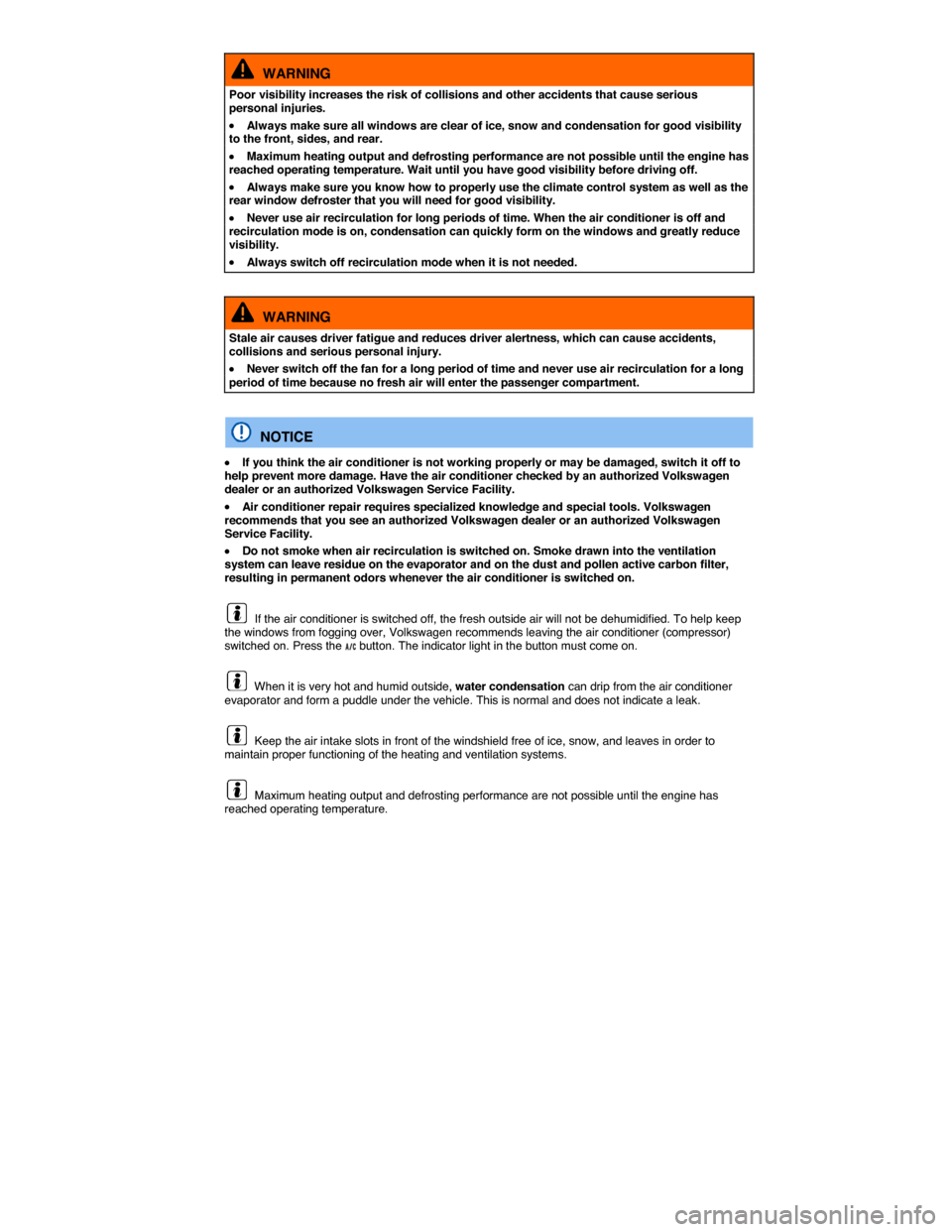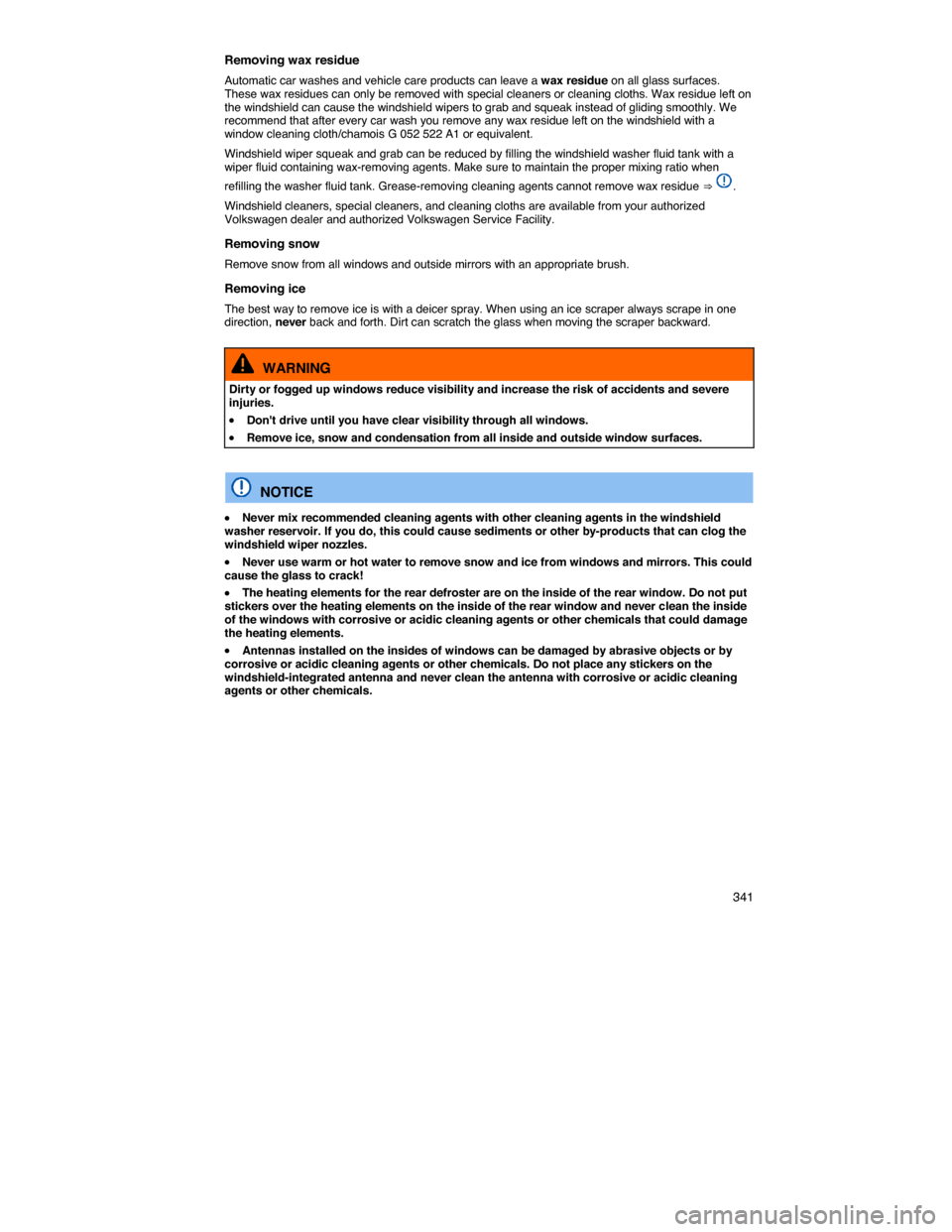2014 VOLKSWAGEN PASSAT CC heating
[x] Cancel search: heatingPage 240 of 429

WARNING
Using an outlet or power cables that are incorrect or damaged, using electrical appliances incorrectly, or ignoring safety precautions can result in short circuits, accidents, injuries, and life-threatening electrical shocks.
�x Never use a damaged outlet or a damaged power cable.
�x Always plug the preheating system into a 120 Volt Ground Fault Circuit (GFI) wall outlet that is properly protected against rain and other moisture.
�x Always check the fuse protection of the 120 Volt power source before using the connecting cable.
�x Always use a 12 gauge or heavier heavy-duty extension cable that can be properly grounded to a three-prong GFI outlet. The extension cable must not be longer than 100 ft (30 meters).
�x Check the cables for damage before every use. Never use a damaged cable. Damaged cables must be replaced. See an authorized Volkswagen dealer or an authorized Volkswagen Service Facility.
�x Only use the cables provided.
�x Always remove the connecting cable before starting the engine.
�x Never attempt to alter or repair cables or other electrical components.
�x Never let plugs or connectors come into contact with water, moisture, or any other fluids.
If the engine preheating system is used occasionally, test the GFI circuit breaker (Ground Fault Circuit Interrupter) once a month. Test it once a week if the system is used regularly.
Page 251 of 429

Emergency shift program
If all selector lever position indicators in the instrument cluster display are highlighted against a bright background, there is a system malfunction. The automatic transmission and the DSG automatic transmission will then operate in the emergency shift program. The emergency shift program lets you drive the vehicle, but at a reduced speed and without being able to use all of the forward gears.
In some cases, vehicles with a DSG® Direct Shift Gearbox automatic transmission may not be able to shift into reverse. It is then impossible to drive the vehicle backwards.
In any event, have the automatic transmission checked by an authorized Volkswagen dealer or authorized Volkswagen Service Facility.
Overheating of Direct Shift Gearbox (DSG®) automatic transmission
The DSG® automatic transmission may overheat, for example, due to frequent starts, extended “creeping,” or stop-and-go traffic. Overheating is indicated by the warning light Á and, if applicable, by a text message in the instrument cluster. An additional warning chime may sound. Stop and let the
transmission cool down ⇒ .
The vehicle does not move forward or in reverse even though a drive position is selected with the selector lever
If the vehicle does not move in the desired direction, the system may not have engaged the drive position correctly. Press the brake pedal and select the drive position again.
If the vehicle still does not move in the desired direction, there is a system malfunction. See your authorized Volkswagen dealer or authorized Volkswagen Service Facility for assistance to have the system checked.
NOTICE
�x As soon as you get any of these warnings about transmission overheating, you must either park the vehicle in a safe place or drive faster than 12 mph (20 km/h).
�x If the text message and acoustic warning repeat themselves every 10 seconds or so, you must park the vehicle in a safe place as soon as you can safely do so and stop the engine. Let the transmission cool down.
�x To help prevent damage to the transmission, do not drive the vehicle again until the acoustic warning has stopped. As long as the engine is overheated, avoid stop and start driving and avoid low speeds (“walking pace”).
Gear recommendation
�
Page 271 of 429

Defensive driving and “flowing” with traffic
Frequent braking and acceleration increase fuel consumption significantly. Just by driving defensively and keeping a sufficiently large distance away from the vehicle in front of you can make up for the speed fluctuations caused by taking your foot off the accelerator. Active braking and accelerating is then not necessarily required.
Calm and smooth driving
Consistency is more important than speed. The more smoothly you drive, the less fuel the vehicle consumes.
When driving on the highway or freeway, a constant, moderate speed is more efficient and economical than constantly accelerating and braking. Usually you can reach your destination just as quickly by driving at a moderate, but steady speed.
The cruise control system can assist in maintaining a uniform driving style.
Moderate use of extra electrical loads
Comfort inside the vehicle is nice and important, but it is important to use them in an environmentally conscious manner.
Some devices can increase fuel consumption when activated (examples):
�x Climate control system (air conditioner): If the air conditioner has to produce starkly contrasting temperatures, it requires a large amount of energy, which is generated by the engine. The temperature in the vehicle should therefore not be extremely different from that of the outside temperature. It may be helpful to ventilate the vehicle before driving and then to drive a short distance with the windows open. After that, switch on the air conditioner with the windows closed. Keep the windows closed when driving at high speeds. Open windows increase fuel consumption.
�x Switch off seat heating once it has served its purpose.
�x Switch off the rear window defroster as soon as the windows are free of fog and ice.
Additional factors that increase fuel consumption (examples):
�x Malfunctioning engine control.
�x Driving in the mountains.
�x Towing a trailer.
NOTICE
Never let the vehicle coast or roll down a hill in Neutral (N), especially when the engine is not running. The transmission will not be lubricated and will be damaged.
Page 291 of 429

Heating and air conditioning
�
Page 292 of 429

WARNING
Poor visibility increases the risk of collisions and other accidents that cause serious personal injuries.
�x Always make sure all windows are clear of ice, snow and condensation for good visibility to the front, sides, and rear.
�x Maximum heating output and defrosting performance are not possible until the engine has reached operating temperature. Wait until you have good visibility before driving off.
�x Always make sure you know how to properly use the climate control system as well as the rear window defroster that you will need for good visibility.
�x Never use air recirculation for long periods of time. When the air conditioner is off and recirculation mode is on, condensation can quickly form on the windows and greatly reduce visibility.
�x Always switch off recirculation mode when it is not needed.
WARNING
Stale air causes driver fatigue and reduces driver alertness, which can cause accidents, collisions and serious personal injury.
�x Never switch off the fan for a long period of time and never use air recirculation for a long period of time because no fresh air will enter the passenger compartment.
NOTICE
�x If you think the air conditioner is not working properly or may be damaged, switch it off to help prevent more damage. Have the air conditioner checked by an authorized Volkswagen dealer or an authorized Volkswagen Service Facility.
�x Air conditioner repair requires specialized knowledge and special tools. Volkswagen recommends that you see an authorized Volkswagen dealer or an authorized Volkswagen Service Facility.
�x Do not smoke when air recirculation is switched on. Smoke drawn into the ventilation system can leave residue on the evaporator and on the dust and pollen active carbon filter, resulting in permanent odors whenever the air conditioner is switched on.
If the air conditioner is switched off, the fresh outside air will not be dehumidified. To help keep the windows from fogging over, Volkswagen recommends leaving the air conditioner (compressor) switched on. Press the �!�
Page 340 of 429

341
Removing wax residue
Automatic car washes and vehicle care products can leave a wax residue on all glass surfaces. These wax residues can only be removed with special cleaners or cleaning cloths. Wax residue left on the windshield can cause the windshield wipers to grab and squeak instead of gliding smoothly. We recommend that after every car wash you remove any wax residue left on the windshield with a window cleaning cloth/chamois G 052 522 A1 or equivalent.
Windshield wiper squeak and grab can be reduced by filling the windshield washer fluid tank with a wiper fluid containing wax-removing agents. Make sure to maintain the proper mixing ratio when
refilling the washer fluid tank. Grease-removing cleaning agents cannot remove wax residue ⇒ .
Windshield cleaners, special cleaners, and cleaning cloths are available from your authorized Volkswagen dealer and authorized Volkswagen Service Facility.
Removing snow
Remove snow from all windows and outside mirrors with an appropriate brush.
Removing ice
The best way to remove ice is with a deicer spray. When using an ice scraper always scrape in one direction, never back and forth. Dirt can scratch the glass when moving the scraper backward.
WARNING
Dirty or fogged up windows reduce visibility and increase the risk of accidents and severe injuries.
�x Don't drive until you have clear visibility through all windows.
�x Remove ice, snow and condensation from all inside and outside window surfaces.
NOTICE
�x Never mix recommended cleaning agents with other cleaning agents in the windshield washer reservoir. If you do, this could cause sediments or other by-products that can clog the windshield wiper nozzles.
�x Never use warm or hot water to remove snow and ice from windows and mirrors. This could cause the glass to crack!
�x The heating elements for the rear defroster are on the inside of the rear window. Do not put stickers over the heating elements on the inside of the rear window and never clean the inside of the windows with corrosive or acidic cleaning agents or other chemicals that could damage the heating elements.
�x Antennas installed on the insides of windows can be damaged by abrasive objects or by corrosive or acidic cleaning agents or other chemicals. Do not place any stickers on the windshield-integrated antenna and never clean the antenna with corrosive or acidic cleaning agents or other chemicals.